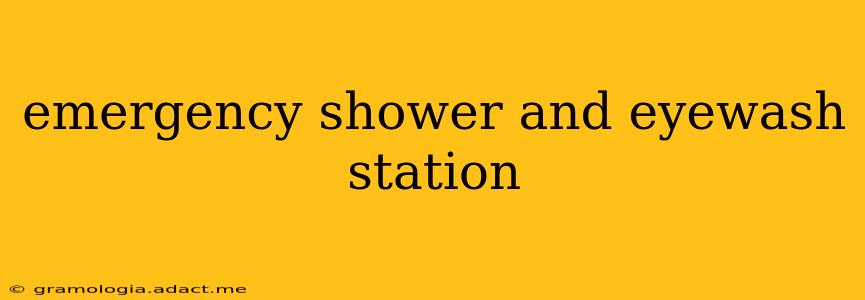Workplace safety is paramount, and a crucial element of this is the readily available emergency shower and eyewash station. These life-saving devices are essential for immediate first aid in the event of chemical splashes or other eye and body contaminations. This guide will delve into the importance, proper use, and maintenance of emergency shower and eyewash stations, answering common questions and providing valuable insights to ensure workplace safety.
What is an Emergency Shower and Eyewash Station?
An emergency shower and eyewash station is a combined safety device designed to provide immediate flushing of the eyes and body in case of chemical spills, splashes, or other hazardous exposures. The eyewash component typically consists of a nozzle or spray head designed to deliver a gentle but forceful stream of water directly to the eyes, while the emergency shower provides a wider spray to rinse the entire body. These stations are crucial in environments where hazardous chemicals are handled, potentially exposing workers to harmful substances. They are designed for immediate first aid, buying valuable time before professional medical assistance arrives.
Why are Emergency Shower and Eyewash Stations Important?
The importance of these stations cannot be overstated. Prompt flushing of contaminated eyes or skin can significantly reduce the severity of injuries caused by chemical exposure. Many corrosive or irritating chemicals can cause irreversible damage within seconds of contact. The immediate action provided by an emergency shower and eyewash station can:
- Minimize chemical burns: Rapid flushing dilutes the chemical concentration and reduces the duration of contact with the skin or eyes.
- Prevent permanent vision loss: Prompt eyewashing can save eyesight in cases of chemical exposure to the eyes.
- Reduce the severity of injuries: Timely intervention can lessen the extent of skin damage and reduce the need for extensive medical treatment.
- Comply with safety regulations: Many industries have strict regulations requiring the installation and maintenance of these safety devices.
How to Use an Emergency Shower and Eyewash Station?
Knowing how to use an emergency shower and eyewash station effectively is just as important as having one installed. In a real emergency, panic can impair judgment, so familiarity with the process is crucial. Here's a step-by-step guide:
- Activate the closest station: Locate the nearest emergency shower and eyewash station.
- Remove contaminated clothing: If possible, remove any clothing that has been contaminated.
- Begin flushing: Activate the eyewash station by pulling the handle or activating the appropriate mechanism. Keep your eyes open and gently move your eyelids to ensure thorough rinsing. For an emergency shower, remove any obstructions and stand directly beneath the shower head.
- Flush for 15-20 minutes: Continue flushing for a minimum of 15 minutes for both eyes and the body. This ensures adequate dilution and removal of the contaminant.
- Seek medical attention: After flushing, seek immediate medical attention, even if you feel no immediate discomfort. Inform medical personnel of the chemical involved.
What should I do if the eyewash station isn't working?
If the eyewash station is malfunctioning, immediately report the issue to your supervisor or safety officer. A non-functional eyewash station is a serious safety hazard. Do not attempt to use a malfunctioning station; find an alternative source of clean water if possible while reporting the defect.
How often should emergency shower and eyewash stations be inspected?
Regular inspections are critical. Frequency depends on local regulations and the specific hazards present, but monthly inspections are a common minimum. These inspections should verify the proper functionality of all components, water flow, and the absence of any obstructions. Documentation of these inspections is essential to demonstrate compliance.
What are the different types of emergency shower and eyewash stations?
There are various types, including portable, wall-mounted, and combination units. The choice depends on the specific workplace needs and the nature of potential hazards. Some incorporate features like temperature regulation and self-closing valves.
How do I maintain an emergency shower and eyewash station?
Regular maintenance is crucial. This includes regular flushing to prevent stagnation and potential bacterial growth, checking water pressure and flow, and visually inspecting for damage or leaks. Specific maintenance procedures will depend on the model and manufacturer’s instructions.
By understanding the importance, proper use, and maintenance of emergency shower and eyewash stations, workplaces can significantly enhance safety and minimize the risk of serious injuries from chemical exposures. Prioritizing these life-saving devices is a critical step in creating a safe and healthy work environment.
